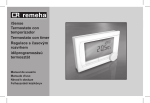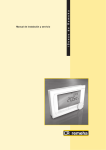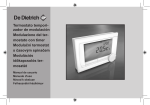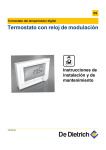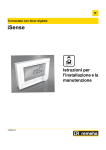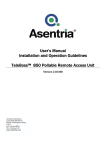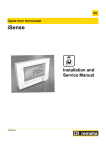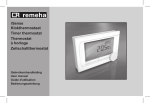Download REMEHA iSense User manual
Transcript
i Sense Timer thermostat User manual 1 Contents 1.Introduction ....................................... 1 2.Overview............................................. 2.1 Display.......................................... 2.2 Buttons.......................................... 1 2 3 3.Installation.......................................... 3.1 Location of the thermostat........... 3.2 Installation and connection.......... 3.3 Location of the outside sensor....... 4 4 4 6 4.Prior to first use................................. 4.1Setting language, time and date................................ 4.2 Default setting............................... 7 7 7 5.Setting................................................. 8 5.1 Three user modes........................ 8 5.2Creating or changing a clock program............................... 9 5.3Setting continuous temperatures................................... 13 5.4 Setting the control strategy........ 14 5.5 Setting a holiday program.......... 17 5.6 Other settings............................. 18 6.Using the iSense.............................. 6.1 Selecting a program................... 6.2Temporarily changing the temperature.......................... 6.3 Fireplace mode........................... 6.4 Information.................................. 19 19 19 20 21 7.Messages.......................................... 21 7.1 Fault messages.......................... 22 7.2 Service message........................ 26 8.Problems and solutions.................. 27 9.Technical specifications................. 32 Appendix: clock program template...... 32 1. Introduction The Remeha iSense is an OpenTherm timer thermostat with many enhanced functions. The iSense is supplied in two versions: • iSense OpenTherm • iSense RF (wireless), with the iBase RF transmitter This manual covers both versions. Where information only pertains to one of the two versions then this is clearly stated. A full description of the Remeha iSense can be found in the Installation and Service manual. This can be downloaded from www.remeha.nl. 2. Overview The iSense is menu-controlled, which means it is very simple to operate: it only has three buttons. Display Menu Button A Program Button B Button C, (push-turn) T000059-06-A 1 2.1 Display Pictograms Time Temperature Textbox menus Menu Mode button A Mode button B Program T000060-06-A Most important pictograms Clock program active Continuous day temperature Continuous night temperature Frost protection Summer mode Manual setting Holiday program DHW standby function switched off Current room temperature Room temperature set Controller requesting heat Central heating boiler on for hot water Central heating boiler on for central heating Warning symbols Water pressure in central heating boiler too low General warning symbol Central heating boiler requires servicing Battery in controller almost empty No wireless connection T001007-A T001001-A 2 2.2Buttons The function of button A and button B depends on the task you are carrying out. The function is shown in the display, immediately above the buttons. B A C Button C is a push-turn button. You press it to confirm choices, such as menu selections. By turning it you can perform various tasks such as scrolling through menus or changing values such as the temperature, time, date and language. T000059-06-B T000153-A 3 3. Installation 3.1Location of the thermostat The iSense is set to room control by default, which means that the inside temperature is used to control the central heating. That is why it is best to locate the iSense on an internal wall in the room in which you spend the most time, such as the living room. Do not locate the controller too close to heat sources (fireplace, radiator, lamp, candles, direct sunlight etc.), or in places where it may be draughty. iSense RF The following also apply for the iSense RF: • Position the iSense at least 1 metre from equipment with electromagnetic emissions such as wireless telephones, TVs, computers, microwave ovens, etc. • Position the iSense so that it has good reception. Take account of the fact that objects containing metal will affect the reception. These include steel-reinforced concrete, mirrors and windows with a metal coating, insulating films etc. i The signal strength can be viewed via Menu > Information. 4 3.2Installation and connection The following must be done before you install and connect the iSense: • Adjust the boiler so that it can be connected to an OpenTherm thermostat. • Turn off the boiler. Consult the boiler documentation for this process. Do this as follows: 1. Open the housing by pulling the front and the base plate apart. T001046-C 2. Attach the base plate of the controller to the wall using the screws and plugs supplied. Ensure that the boiler's connecting wires are protruding through the hole in the base plate. OT 3. Connect the thermostat to the boiler OpenTherm connection and the controller OT connection. OpenTherm is polarity insensitive; you may therefore swap the wires. OT T000062-C 5 4. Place three AA batteries in the thermostat if required. These are not provided. The batteries ensure that the clock keeps running when the boiler is switched off. The batteries also power the backlight for the iSense for boilers that do not have OpenTherm Smart Power. If you have a boiler with Smart Power, then the backlight for the iSense also works without batteries. (iSense RF only) Place 3 AA batteries in the thermostat. These are required to operate the iSense RF. T001042-B i The programs that are set are saved if the boiler or the iSense is switched off (even if there are no batteries). The iSense RF automatically starts communicating with the iBase. 3.3Location of the outside sensor An outside temperature sensor is not supplied as standard with the iSense. You only require this sensor if you want weather-compensated control of the inside temperature. The following guidelines apply with regard to choosing a location for an outside temperature sensor: • Install the outside sensor on the north or north-west side of the home, away from direct sunlight. • The sensor must be positioned at least 2.5 metres above ground level. • Do not install the outside sensor near windows, doors, ventilation grills, extractors, etc. Consult the documentation for your boiler for information on connecting an outside temperature sensor. 6 4. Prior to first use 4.1Setting language, time and date The menu for selecting the language (international version) or setting the time (Dutch version) appears when you connect the iSense. 1. Select the desired language if applicable by turning button C and then push button C to confirm. 2. Follow the instructions on the display to select the time, year, month and day. The controller is now ready for use. After installation, the default program is activated (see paragraph 4.2). The temperature is now controlled by this clock program. i The thermostat automatically switches between summer time and winter time settings. 4.2Default setting Room control The iSense is set to room control by default. This means that the flow temperature of the central heating water is controlled by the temperature in the room where the iSense is installed. Weather-compensated boiler control is also possible (with outside sensor); in other words based on the outside temperature. The controller has a programmed heating curve which determines the water flow temperature together with the outside temperature. The heating curve must be chosen so that the least favourable room can be efficiently heated even when the outside temperature is very low. See paragraph 5.4 for further information about weather-compensated control. 7 Clock program The default clock program sets the temperature each day as follows: • 06:00 –19:00: 20°C (7 days) • 19:00 – 23:00: 21°C (7 days) • 23:00 –06:00: 15°C+ (7 days) You can of course adapt the clock programs to your own requirements. See Chapter 5. 5. Setting 5.1 Three usage modes The iSense has three usage modes: • Basic: no clock programs are used in this mode. You can only set the temperature on the thermostat manually. • Normal: this is the standard mode. Most options are available, such as the clock program. • Advanced: this mode lets you use two standard clock programs (A and B), change more settings and request more detailed information. You can change the usage mode via the menu: Menu > Settings > User settings > Usage mode. i This manual deals with most functions relating to the 'Normal' mode. This is the default mode after initial start-up. 8 5.2Creating or changing a clock program A clock program automatically controls the temperature for a day, and can be set for each individual day. You can adjust the default clock program or enter a completely new program. i The iSense starts pre-heating prior to the set time by default, so that the room has reached the desired temperature at the correct time. Making an overview It is useful to draw up your own overview with switch times: what temperature does it need to be and when in your home? This of course depends on who is at home when, what time you get up etc. You can set up to six switch times per day. 9 An example of an overview is shown below: Time MO. TU. WE. TH. FR. SA. SU. 7:00 9:00 11:00 13:00 15:00 17:00 19:00 21:00 23:00 0:00 T001003-06-A i There is an overview template at the back of this manual that you can use for your own clock program. 10 Creating a new clock program 1. Select Menu > Program > Clock program > New. 2. Select an initial program if appropriate (Daytime home, Midweek home or Weekend home). You can now create your own clock program based on this program. Press button C to confirm. 3. Go to the day for which you want to set the clock program. Press button C to confirm. 4. Go to the time you want to set. Press button C to confirm. i You can use the Remove button to remove the selected switch time. 5. Use button C to set the time and the corresponding desired temperature. 6. Once you have set all switch times for a particular day, you can copy the settings for that day to other days: - Go to the day. - Press Copy. - Select the day(s) to which you want to copy the settings using button C and press Save. 7. Go to the day. Then press button C. 8. Go to step 3 to set the next day, or press Back to close this menu. 11 Changing an existing clock program 1. Select Menu > Program > Clock program > Change. 2. Go to the day for which you want to change the clock program. Press button C to confirm. 3. Go to the time you want to change. Press button C to confirm. i You can use the Remove button to remove the selected switch time. 4. Use button C to set the time and the corresponding desired temperature. 5. Once you have set all switch times for a particular day, you can copy the settings for that day to other days: - Go to the day. - Press Copy. - Select the day(s) to which you want to copy the settings using button C and press Save. 6. Go to the day. Then press button C. 7. Go to step 2 to set the next day, or press Back to close this menu. Restoring the default settings Select Menu > Program > Clock program > Factory program to restore the settings for the default clock program. 12 5.3Setting continuous temperatures Instead of the clock program, you can also set the room temperature continuously to a particular value. You can set three different continuous temperatures via Menu > Program: • Day temp.: room temperature during the day, corresponding to the “Continuous day” program. • Night temp.: room temperature at night, corresponding to the “Continuous night” program. • Frost temp.: room temperature to protect the room where the controller is installed from freezing. This setting comes under the “Frost protected” program. i The programs mentioned are explained in paragraph 6.1. 13 5.4Setting the control strategy The iSense lets you use the room control and/or weather-compensated control strategies in various ways. You can select a control strategy via Menu > Settings > System > Control strategy. Specific settings for weather-compensated control If you have opted for a weather-compensated control strategy, a number of extra settings are available via Menu > Settings > System > OTC settings. Heating curve: • Base point outside: outside temperature base point • Base point flow: flow temperature base point • Climate point outside: outside temperature climate point • Climate point flow: flow temperature climate point • Curvature: degree of curvature of the heating curve, depending on your central heating system. Select the relevant type of heaters: underfloor heating, radiators or convectors. This will provide more comfort early and late in the year. i The heating curve is based on an outside temperature of 20°C. When the desired room temperature is increased, the heating curve shifts upwards. The degree of increase is determined using the “RT effect” function. • RT effect: factor influencing the shift in the heating curve • Day temperature limit: outside temperature above which the central heating is switched off during the day. The day temperature limit is relevant when the desired room temperature is 14 • higher than the night temperature that has been set via Menu > Program > Night temperature Night temperature limit: outside temperature above which the central heating is switched off during the night. The night temperature limit is relevant when the desired room temperature is the same as or lower than the night temperature that has been set via Menu > Program > Night temperature 15 Heating curve – an example 100 Climate point Increased room temperature during the day 90 80 Desired room temperature of 20ºC during the day 70 Boiler temperature (ºC) 60 50 40 Base point 30 Desired room temperature of 15ºC during the night 20 10 0 -15 -5 0 Outside temperature (ºC) 5 15 25 T001032-06-A i See also see day/night temperature limit 12.4 The settings for the heating curve are highly dependent on the design of the central heating system and the home. This means that no clear advice can be given on this matter. The heating curve can be optimised during use. The heating curve also shifts upwards or downwards when the temperature is increased or decreased. 16 5.5Setting a holiday program It can be useful to set a holiday program if you are away from home for some time. This ensures a constant temperature in your home for the period you set. You set the temperature yourself. A holiday program automatically takes effect at 0.00 hours on the start date and ends at 0.00 on the end date. The symbol appears in the display. This program is switched off and removed once the period set has ended. T001001-B You can set a maximum of 16 holiday programs. You do this via Menu > Program > Holiday prog.: • Select View to look at the holiday programs set. • Select Change to change or remove programs. • Select Enter to add a new program. • Select Desired temp. to set the constant temperature. 17 5.6Other settings You can change a number of settings via the Settings menu. These are summarised here; a more detailed explanation can be found in the Installation and Service manual. • Language and display settings. • Calibration: you can calibrate the sensor by positioning an accurate thermometer next to the controller. • Comfort correction: iSense takes into account the perceived temperature. • Frost protection: if an external sensor is connected, the outside temperature will be used to switch on the frost protection automatically. If the outside temperature falls below the set value, the pump will continue to run and the central heating water will not get colder than 10°C. • Anti-legionella (only for calorifiers): to prevent legionella growth, you are advised to heat the calorifier up to 65°C once a week. • Tap water temperature: set the desired tap water temperature; for boilers with a temperature program where applicable. • DHW standby: used to indicate when the tap water needs pre-heating. If the tap water is preheated, hot water will be available more quickly. • Digital input: to have the iSense carry out tasks from an external module, for example during overtime. • 5 different control strategies based on room control and/or weather-compensated control. • Specific central heating system settings, such as the home's heating and cooling rate. 18 6. Using the iSense 6.1Selecting program You can select one of the following programs via Program in the main display: • Clock program: the central heating temperature is controlled by the program you have set. • Continuous day: the temperature remains constant at the day temperature you have set. • Continuous night: the temperature remains constant at the night temperature you have set. • Frost protection: the temperature remains constant at the frost protection temperature you have set. DHW standby is switched off for this program. • Continuous summer: the temperature remains constant at the night temperature, whereby the tap water is on standby between 6.00 and 23.00 (which means that you will get hot water more quickly). 6.2Temporarily changing the temperature You can (temporarily) switch off a selected clock program or continuous program at any time by setting the temperature manually. 1. Turn button C from the main display to set a new temperature. 2. Press Adjust time if you also want to set an end time for the manually-selected temperature, and select this time using push-turn button C. i If you do not select an end time and a clock program was active, that clock program will become active again at the next switch point. Manual operation will then be switched off. 19 3. Press Adjust date if you also want to set an end date for the manually selected temperature, and select this time using push-turn button C. 4. Press button C to return to the main menu or wait five seconds until the thermostat automatically returns to the main menu. Press the Next program button to cancel the manual temperature change. 6.3Fireplace mode Once the temperature has reached the desired level in the room where the iSense has been positioned, the central heating switches off. This may be inconvenient if, for example, you have an open fire or if a lot of people are present in that room. Other rooms in the house are also no longer heated in this situation. You can switch on the fireplace mode via the Program button so that the other rooms are still heated. This switches off the built-in room sensor in the iSense. The temperature of the central heating water at that point is then maintained. If it becomes too cold or too hot in the other rooms, you can increase or decrease the room temperature there using push-turn button C on the iSense. This increases or decreases the central heating water temperature. You can fit thermostat valves to the radiators in order to individually control the temperatures in these rooms. i The fireplace mode should only be activated if the iSense uses the room temperature to control the temperature. 20 i We advise that you close the radiator valves in the room in which the iSense has been positioned to prevent the room temperature there becoming too high. i The controller switches to weather-compensated control if the outside temperature sensor is used. 6.4Information You can request operating information about your central heating system, such as the water pressure in the central heating system and various temperatures, via Menu > Information. The information available depends on your central heating unit. The “Basic” and “Normal” modes do not show all information categories which are available. Select More information to make all information available. 7. Messages This is what a fault message or service message looks like: No connection to outside sensor Fault indication Display text Menu Program T000063-06-A 21 7.1 Fault messages F200: No connection to outside sensor Fault indication Fault code F200 and are lit up. Display text No connection to outside sensor. Solution Check the boiler's connection to the outside temperature sensor. T001014-06-A F203: Faulty connection to boiler Fault indication Fault code F203 is lit up. Display text Communication fault. Check the connection. Solution Check the connection to the boiler. T001009-06-A 22 F214: Incorrect room temperature reading Fault indication Fault code F214 is lit up. Display text Room temperature is out of measuring range or sensor is defective. Solution Room temperature reading is incorrect. If the room temperature is between -5ºC and 65ºC, the temperature sensor may be faulty. Contact your installer. T001015-06-A F215: Controller failure Fault indication Fault code F215 is lit up. Display text Internal fault. Controller failure. Solution Contact your installer. T001008-06-A 23 F216: No connection with base station (iSense RF only) Fault indication Fault code F216 and are lit up. Display text Wireless communication fault. Solution Check whether the iBase for the boiler is on and is functioning correctly (consult the transmitter manual if necessary). If there is no connection between the iSense and iBase, then restore the connection as follows: Put the iBase in connection mode. Consult the iBase manual for this. On the iSense select Menu > Settings > User settings > Connection. If this does not solve the problem, look for another location for the iSense and/or iBase or remove “obstacles” that could interfere with the RF signal. T001008a-06-A 24 Water pressure too low Fault indication Current water pressure and are lit up. Display text The water pressure in your central heating system is too low. Solution Top up the water in the central heating system. See the documentation for your boiler. T001011-06-A E-code: boiler failure Fault indication E-code Display text Boiler failure. Consult the fault table in the user manual for the boiler. Solution Use the E-code to find the fault in the central heating boiler's documentation. is lit up. T001013-06-A 25 Controller batteries flat Fault indication and are lit up. Display text - Solution The batteries are almost empty. Replace the three AA batteries. T001016-06-A 7.2 Service message Boiler service required Fault indication Display text Maintenance service type (A, B or C) required. Contact your installer. is lit up. Solution Contact your installer to have the central heating boiler serviced. T001033-06-A 26 8. Problems and solutions Problem The central heating is coming on too early in the morning. Solution Adjust the Max. pre-heating time setting (see the installation and service manual). The home may well not be up to temperature on time as a result. T001019-06-A Problem The home is not warm on time. Solution - Open the radiator valve further when the radiators warm up. - Increase the Max. pre-heating time (see the installation and service manual). - Increase the desired Heat up rate by adjusting this to Fastest, for example (see the installation and service manual). For weather-compensated control you have the following options: - Set the radiator thermostat valves correctly. - Adjust the heating curve (see the installation and service manual). - Change the control strategy (see the installation and service manual). There may also be technical problems with the central heating installation. In that case contact your installer. T001020-06-A 27 Problem The house is too warm. Solution Weather-compensated control means that no account is taken of the measured room temperature. Solve the problem in one of the following ways: - Set the radiator thermostat valves correctly. - Reduce the heating curve (see the installation and service manual). - Change the control strategy (see the installation and service manual). Room control may mean that the heat up rate is too high or that the controller is not correctly calibrated. T001021-06-A Problem The house does not become warm enough. Solution Weather-compensated control means that no account is taken of the measured room temperature. Solve the problem in one of the following ways: - Set the radiator thermostat valves correctly. - Increase the heating curve (see the installation and service manual). - Change the control strategy (see the installation and service manual). T001022-06-A 28 Problem It takes too long for the tap water to get up to temperature. Solution - Boiler: the DHW standby function may be switched off. In that case the symbol is shown in the display. Control the DHW standby with the DHW standby setting (see the installation and service manual). - Boiler: the boiler may be heated up too late. Set the tap water temperature using the Tap water temperature setting (see the installation and service manual). T001023-06-A Problem The boiler supplies no hot water or hot water only briefly. Solution The DHW standby function may be switched off. Switch the DHW standby function to “Continuous” (see paragraph 9.2). T001254-06-A 29 Problem The boiler starts heating the home or the tap water at night even though the controller is set low. Solution - Weather-compensated control (OTC) means that the boiler is controlled by the outside temperature. This can be prevented by adjusting the Night temperature limit or selecting another control strategy. See the installation and service manual. - The boiler can start pre-heating before the following set point. Adjust the Max. pre-heating time setting (see the installation and service manual). The home may well not be up to temperature on time as a result. - The tap water is only heated when the room temperature set is higher than the night temperature. See the installation and service manual for details of how to change the night temperature. T001024-06-A 30 Problem The temperature measurement differs from that which I am used to. Solution Correct the temperature measurement via the Calibration setting (see the installation and service manual). T001025-06-A Problem The display does not function. Solution Check that the wiring is correct and that the plug for the boiler is in the wall socket. T001026-06-A Problem The backlight for the display does not work. Solution Your boiler may not support OpenTherm Smart Power. In that case fit batteries in the iSense (see paragraph 3.2). T001027-06-A 31 9. Technical specifications Dimensions 96 x 144 x 34 (l x w x h) in mm Height excluding buttons 96 x 144 x 25 (l x w x h) in mm Power supply iSense OpenTherm Via OpenTherm iSense RF Via batteries Electrical connection iSense OpenTherm OpenTherm communication. Connection for low-voltage wires iSense RF Bi-directional secure communication Batteries 3 x AA batteries. Lifetime: dependent on the brand of battery Digital input Potential-free contact (switch) Ambient conditions Storage conditions Temperature: -25°C – 60°C Relative humidity: 5% – 90%, no condensation Operating conditions Without batteries: 0°C – 60°C. With batteries: 0°C – 55°C Temperature Room temperature Measurement range: -5°C – 65°C Maximum temperature deviation at 20°C: 0.3°C 32 Outside temperature The measurement is taken in the boiler and passed to the controller. Consult the boiler documentation regarding the accuracy of the measurement. Set temperature range 5 – 35°C Calibration options Inside and outside temperature sensor: -5 to + 5 in steps of 0.5°C Control Modulating temperature control The control can be optimised Room control Overshoot: maximum 1°C after pre-heating Temperature variation: less than 0.25°C Control strategies Room temperature control Weather-compensated control 3 combination options Features of the controller Backlight Colour: blue Date/time indication Time: 24 h clock. Accuracy: to about 365 seconds per year Date: day – month – year Automatic switching to summer time Programs 2 clock programs with 6 switch points per day Boiler clock program with 6 switch points per day 16 holiday programs Day, Night, Frost protection, Summer mode, Fireplace 33 Setting accuracy Temperature: 0.5°C. Clock program: 10 minutes Wireless range (iSense RF) Approximately 8 metres through 2 concrete layers (depending on the surroundings, see paragraph 3.1) Operation Menu-controlled using push buttons and a push-turn button Installation Directly on the wall using screws or built-in junction box as per standards. Built-in system possible using built-in part (art. S100994) Quality marks and EMC: 89/336/EEC – EN50165(1997), 55014, 55022 compliance with standards Emission EN61000-6-3 Immunity EN61000-6-2 Drop test: IEC 68-2-32 RoHS compliant OpenTherm V3.0 certified (iSense OpenTherm only) ETSI 220-300 TBD (iSense RF only) Protection class IP20 for wall installation, IPx4 for the built-in system. 34 Appendix: clock program template Time MO. TU. WE. TH. FR. SA. SU. Time 0 0 ._ _ 12.__ 0 1 ._ _ 13.__ 0 2 ._ _ 14.__ 0 3 ._ _ 15.__ 0 4 ._ _ 16.__ 0 5 ._ _ 17.__ 0 6 ._ _ 18.__ 0 7 ._ _ 19.__ 0 8 ._ _ 20.__ 0 9 ._ _ 21.__ 1 0 ._ _ 22.__ 11 ._ _ 23.__ MO. TU. WE. TH. FR. SA. SU. T001004-06-A i Switch points can be set to a precision of 10 minutes. Enter the switch points as required. 35 118037 - 260608 118037








































